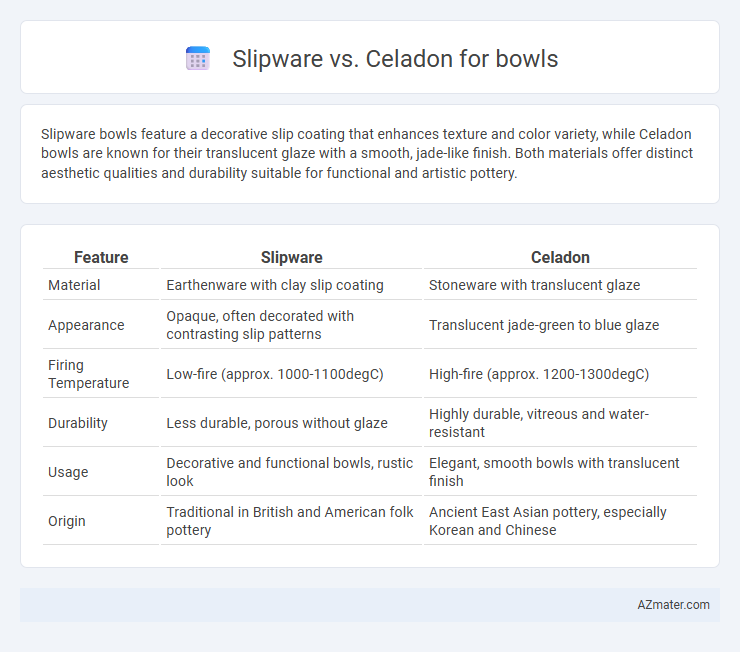Slipware bowls feature a decorative slip coating that enhances texture and color variety, while Celadon bowls are known for their translucent glaze with a smooth, jade-like finish. Both materials offer distinct aesthetic qualities and durability suitable for functional and artistic pottery.
Table of Comparison
| Feature | Slipware | Celadon |
|---|---|---|
| Material | Earthenware with clay slip coating | Stoneware with translucent glaze |
| Appearance | Opaque, often decorated with contrasting slip patterns | Translucent jade-green to blue glaze |
| Firing Temperature | Low-fire (approx. 1000-1100degC) | High-fire (approx. 1200-1300degC) |
| Durability | Less durable, porous without glaze | Highly durable, vitreous and water-resistant |
| Usage | Decorative and functional bowls, rustic look | Elegant, smooth bowls with translucent finish |
| Origin | Traditional in British and American folk pottery | Ancient East Asian pottery, especially Korean and Chinese |
Introduction to Slipware and Celadon Bowls
Slipware bowls feature a distinctive decorative technique using liquid clay slip applied to the surface before firing, resulting in tactile, often rustic patterns that highlight craftsmanship. Celadon bowls are renowned for their translucent, pale green glaze, achieved through iron oxide in a reduction kiln atmosphere, offering a smooth, glass-like finish and elegant aesthetic. Both styles represent unique historic glazing traditions valued for durability and artistic expression in ceramic bowls.
Historical Origins of Slipware and Celadon
Slipware originated in ancient Mesopotamia and flourished in Europe during the medieval period, characterized by its use of liquid clay slip to create intricate patterns and decorative designs on pottery. Celadon, with origins in ancient China during the Eastern Han Dynasty, is distinguished by its translucent jade-green glaze derived from iron oxide in a reducing kiln atmosphere. Both techniques reflect deep cultural histories and craftsmanship, with slipware emphasizing painted or incised decoration and celadon prized for its smooth, glass-like surface and subtle color variations.
Key Characteristics of Slipware Bowls
Slipware bowls are characterized by their decorative slip coating, which allows for intricate patterns and vibrant colors created through the application of liquid clay. These bowls often exhibit a tactile texture due to the layering of slip, offering a rustic, handcrafted appearance distinct from the smooth, glossy finish of celadon. Slipware's porous surface contrasts with celadon's translucency, providing unique aesthetic and functional qualities tailored to artisanal pottery enthusiasts.
Defining Features of Celadon Bowls
Celadon bowls are characterized by their translucent, pale green glaze achieved through iron oxide firing in a reduction kiln, creating a smooth, glass-like surface that enhances intricate carved or incised designs. Unlike slipware, which uses colored slip for decorative patterns on a more textured body, celadon emphasizes subtle elegance through its uniform, glossy finish and muted tones. This distinctive glaze also provides durability and a timeless aesthetic valued in traditional East Asian pottery.
Materials and Techniques Used
Slipware bowls involve coating pottery with a liquid clay slip, often colored for decorative effects, before firing to create textured or painted surfaces. Celadon bowls use a transparent glaze derived from iron oxide that produces a smooth, jade-like finish after a specific reduction firing process in a kiln with controlled oxygen levels. The slipware technique emphasizes decorative layering and contrast, while celadon highlights translucent glaze and subtle color variations through precision in firing techniques.
Aesthetic Differences: Colors and Textures
Slipware bowls showcase rich, earthy tones with lively, hand-painted designs that create a rustic and tactile texture, emphasizing artisanal charm and individuality. Celadon bowls feature a smooth, translucent glaze in pale greens or blues offering a sophisticated, glossy finish that highlights subtle crackle patterns and a refined, delicate aesthetic. The contrast in aesthetics lies in Slipware's vibrant, textured surface versus Celadon's serene, polished elegance.
Durability and Practical Use in Daily Life
Slipware bowls, made with a slip-coated earthenware clay, offer moderate durability and resist chipping better than plain pottery but remain more fragile compared to stoneware. Celadon bowls, featuring a high-fired porcelain base with a translucent glaze, provide superior strength and chip resistance, making them ideal for daily use. Celadon's non-porous surface also resists stains and absorbs less moisture, enhancing its practicality for everyday dining and easy cleaning.
Cultural Significance of Slipware vs Celadon
Slipware bowl techniques showcase rich folk art traditions rooted in European and Asian cultures, reflecting everyday life through decorative slip trailing and sgraffito patterns. Celadon bowls, associated with ancient Chinese and Korean dynasties, symbolize elegance and spiritual harmony through their translucent jade-green glaze, often linked to prosperity and refinement. The distinct cultural significance of slipware versus celadon lies in slipware's rustic, narrative expression compared to celadon's sophisticated, meditative aesthetic in pottery heritage.
Collectibility and Market Value Comparison
Slipware bowls, distinguished by their decorative techniques using liquid clay slips, hold significant appeal among collectors favoring traditional craftsmanship and vibrant surface patterns, often yielding moderate market values. Celadon bowls, prized for their translucent glaze and subtle color palette, command higher market values due to their historical significance and rarity, particularly those originating from renowned East Asian kilns. Collectibility of Celadon is driven by its aesthetic refinement and cultural heritage, whereas Slipware's value appreciates with the intricacy of design and regional provenance.
Choosing the Right Bowl: Slipware or Celadon?
Slipware bowls feature a rustic, textured surface created by applying liquid clay slip, resulting in vibrant patterns and a tactile feel ideal for artisanal or traditional table settings. Celadon bowls offer a smooth, translucent glaze with subtle green or blue hues, prized for their elegant, refined aesthetic and durability in everyday use. Choosing between slipware and celadon bowls depends on whether you prioritize decorative, handcrafted appeal or a sleek, timeless finish that complements minimalist decor.

Infographic: Slipware vs Celadon for Bowl
 azmater.com
azmater.com